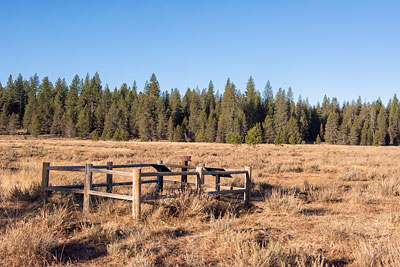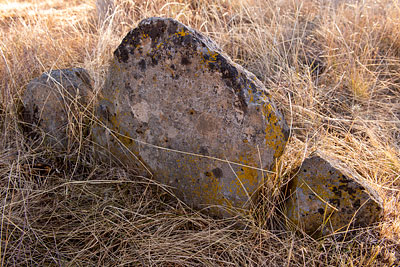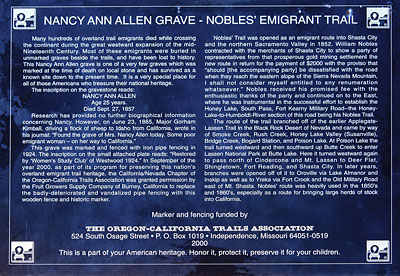Lassen County Points of Interest
Bridge Creek Springs Road
Lassen National Forest
The marker reads:
Nancy Ann Allen Grave
Nobles' Emigrant Trail
Many hundreds of Overland Trail emigrants died while crossing the continent during the great westward expansion of the mid-Nineteenth Century. Most of these emigrants were buried in unmarked graves beside the trails, and have been lost to history. This Nancy Ann Allen grave is one of the very few graves which was marked at the time of death on local stone and has survived as a known site down to the present time. It is a very special place for all of those Americans who treasure their national heritage.
The inscription on the gravestone reads:
Nancy Ann Allen
Age 25 years
Died Sept. 27, 1857
Research has provided no further biographical information concerning Nancy. However, on June 23, 1865, Major Gorham Kimball, driving a flock of sheep to Idaho from California, wrote in his journal: "Found the grave of Mrs. Nancy Allen today. Some poor emigrant woman - on her way to California."
This grave was marked and fenced with iron pipe fencing in 1924. The inscription on the small attached plate reads: "Restored by 'Women’s Study Club' of Westwood 1924." In September of the year 2000, as part of its program for preserving this nation's overland emigrant trail heritage, the California/Nevada Chapter of the Oregon-California Trails Associations was granted permission by the Fruit Growers Supply Company of Burney, California, to replace the badly-deteriorated and vandalized pipe fencing with this wooden fence and historic marker.
Nobles' Trail was opened as an emigrant route into Shasta city and the northern Sacramento Valley in 1852. William Nobles contracted with the merchants of Shasta City to show a party of representatives from that prosperous gold mining settlement the new route in return for the payment of $2000 with the proviso that "should [the accompanying party] be dissatisfied with the road when they reach the eastern slope of the Sierra Nevada Mountain, I shall not consider myself entitled to any renumeration whatsoever." Nobles received his promised fee with the enthusiastic thanks of the party and continued on to the East where he was instrumental in the successful effort to establish the Honey Lake, South Pass, Fort Kearny Military Road -- the Honey-Lake-to-Humboldt-River section of this road being the Nobles Trail.
The route of the trail branched off of the earlier Applegate-Lassen Trail in the Black Rock Desert of Nevada and came by way of Smoke Creek, Rush Creek, Honey Lake Valley Ridge (Susanville), Bridge Creek, Bogard Station, and Poison Lake. At Poison Lake the trail turned westward and then southward up Butte Creek to enter Lassen National Park at Butte Lake. Here it turned westward again to pass north of Cindercone and Mt. Lassen to Deer Flat, Shingletown, Fort Reading, and Shasta City. In later years, branches were opened of it to Oroville via Lake Almanor and Inskip via Fort Crook and the Old Military Road east of Mt. Shasta. Nobles' route was heavily used in the 1850's and 1860's, especially as a route for bringing large herds of stock in to California.
Marker and fencing funded by the Oregon-California Trails Association
This is a part of your American heritage. Honor it, protect it, preserve it for your children.


